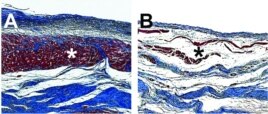Skip to comments.
Researchers Develop Injectable Gel to Repair Damaged Hearts
Voice of America ^
| February 21, 2013
| Jessica Berman
Posted on 02/25/2013 9:31:30 PM PST by neverdem
People who suffer heart attacks are at increased risk of having a second and potentially fatal occurrence because of the damage the heart attack does to cardiac muscle tissue. Now scientists at the University of California San Diego have developed a new biomaterial - an injectable hydrogel - that can repair the damage from heart attacks, and help promote the growth of new heart tissue.
Millions of people around the world suffer heart attacks every year and survive. These traumatic events occur when blood supply to the heart muscles is somehow blocked, robbing them of oxygen and causing them to die. They raise the possibility of subsequent heart attacks, as well as heart failure, and a higher likelihood of death within five years.
The problem, say experts, is the development of scar tissue in the damaged cardiac muscle. Initially helpful in healing the heart, the tough scar tissue actually weakens the supportive protein scaffold, or matrix, that normally exists in the space between heart muscle cells. This scaffold can support and promote the growth of new cells -- except when it's destroyed by post-heart attack scar tissue.
“So we thought the best thing to deliver to the heart would be what was initially there in the first place," said Karen Christman, who is a biomedical engineer interested in tissue regeneration. "And so we developed this liquid form of this cardiac extracellular matrix that once it goes into the tissue can reassemble into that natural scaffold.”

Microscopic images of pig hearts damaged by heart attack show the growth of new heart muscle tissue (shown in red, Figure A) after treatment with an injectable hydrogel compared to a heart left untreated (Figure B, right). Image Credit: Karen Christman, UC San Diego Jacobs School of Engineering.
Next, the material was liquefied and injected directly into the hearts of subject pigs who had experienced heart attacks.
When the cardiac liquid reached body temperature, Christman says, it became a semi-solid gel that formed a new scaffold in damaged areas of the heart. That encouraged new cell growth, she adds, and a more normal, less scar-prone tissue repair.
“When we looked after three months after we had given the treatment, we found a significant increase in cardiac muscle as well as a decrease in scar tissue," she said. "And while we were hoping to see that, that was an exciting new finding since ideally after a heart attack you want to reduce as much scar as possible and get as much muscle as possible.”
Christman says she and her colleagues hope to begin human trials with this minimally-invasive heart repair technique sometime later this year in Europe. The injectable gel would again be produced from pig-heart tissue. Porcine heart valves are frequently used to repair human hearts because they don't cause serious rejection problems in transplant recipients.
The University of California's Karen Christman made her comments in an interview with the journal Science Translational Medicine, which published the article on the cardiac hydrogel.
TOPICS: Culture/Society; News/Current Events; Testing
KEYWORDS: cad; chd; extracellularmatrix; heart; heartdisease; heartrepair; myocardialinfarction; regenerativemedicine; scartissue; tissueengineering
Navigation: use the links below to view more comments.
first previous 1-20, 21-23 last
To: 1010RD
Absolutely, thanks for asking!
To: Pride in the USA
Thanks for the ping, otherwise I’d have missed this one.
It never ceases to amaze me that we have the capacity to create such miracles in medicine and science. Thank God that we are so fearfully and wonderfully made in His image.
If this particular development proves out during the human trials, it will be a quantum leap in the treatment and life expectancy of cardiac patients. Amazing.
22
posted on
02/26/2013 8:50:19 AM PST
by
lonevoice
(Today I broke my personal record for most consecutive days lived)
To: neverdem
Might also work with badly sprained ligaments...Ligaments are slow to heal due to very low blood supply going to them. A badly strained ligament is not torn in half. It has many micro-tears that heal as scar tissue so the ligament may not be as good and resilient as it once was.
Maybe this injection can help
http://getprolo.com/why_ligaments_do_not_heal_on_their_own.htm
23
posted on
02/26/2013 8:59:05 AM PST
by
dennisw
(too much of a good thing is a bad thing --- Joe Pine)
Navigation: use the links below to view more comments.
first previous 1-20, 21-23 last
Disclaimer:
Opinions posted on Free Republic are those of the individual
posters and do not necessarily represent the opinion of Free Republic or its
management. All materials posted herein are protected by copyright law and the
exemption for fair use of copyrighted works.
FreeRepublic.com is powered by software copyright 2000-2008 John Robinson
